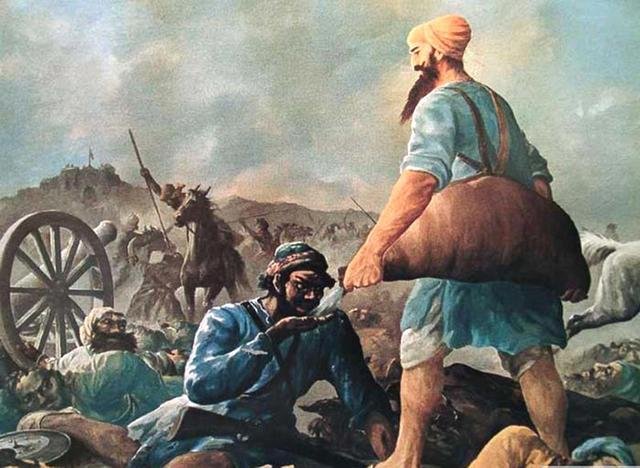HUMAN SAVAGERY & NOBILITY
I.J. Singh
The more than periodic reports of the shooting of Blacks by the Police in this country (USA) are now almost a routine. Hardly a week goes by without one. And there is always a loophole in law or circumstances such that the police shrug off pretty much all responsibility.
Today I revisit a new incident with a different moral. Just days ago (July 26, 2015) The New York Times carried a long absolutely riveting report, even though it was buried on pages 14 and 16, it took a whole page worth of space.
We all know of human nature at its worst but this incident takes us to human nature at its best.
A Quiet Act of Decency Soars Over Messages of Hate is how The Times titled this report. The human story is in its essence a retelling of the beauty and the beast.
|
|
|
Photo by Stephan Morton AP |
It’s a simple event that has occupied us over the past few weeks. It started with the killing of nine Blacks during Bible discussion at a historic Black church in Charleston, South Carolina. In a blatant display of cold heartedness, the young White supremacist killer joined the Bible Study where he was welcomed, and after a while took out his gun to shoot the people.
But this did not lead to rioting in the streets. President Obama and Vice President Biden appeared at the memorial service, as did Governor Nicky Haley of South Carolina, along with many national and state leaders. More significantly, relatives of the massacred publicly forgave the killer. And the emphasis shifted towards two goals: 1. Working towards a constructive dialog and structure for fair and visible justice, and 2. Improving the quality and direction of the rhetoric on race relations in the United States.
Heaven knows we need them both despite the fact that the Civil War freed the Blacks 150 years ago and the Voting Rights Act dates from 50 years ago.
The momentum shifted to visible markers of slavery and racial injustice that stick in the craw every day in the southern half of the country. For instance, chapters of the Ku Klux Klan still exist, though not quite as openly as they used to; statues of rebel politicians and generals of that day and markers of that pre-civil war slave society still occupy an honored place. Confederate flags still fly at state Capitol buildings.
Quite expectedly, a large protest against such presence erupted. But this time many Whites joined it too, just as they were equally important to the civil rights struggle in the 1960’s.
As expected, there were also many White voices that did not want to see any changes in the structure of the society or its icons from 150 years ago – particularly in the demand to remove the Confederate flags from government buildings.
Finally, the state of South Carolina ordered that those flags be moved to a museum for they are a part of history but no longer define the state today. Both ends of the spectrum were represented at the occasion. The segregationists exist even today and they protested — wearing Swastikas and other regalia of a segregated society and waving Confederate flags.
So much for man’s brutality to man. Let’s now shift the story to human nobility.
It was a hot day. One old White man in a segregationist shirt climbing the stairs suddenly felt faint. He might have fallen and gotten seriously injured except that a Black Police Officer saw him collapsing, rushed to him, and along with another Black Officer helped him up, got him to a resting spot and gave him aid.
Forget not that this was a Black man helping a White segregationist in a situation where the battle lines are drawn to showcase the centuries old hatred of each other. What the Black officers saw was not an enemy but a man in need of help. They did their duty.
I am reminded of the government inspired killings of Sikhs in several cities of India in 1984. We know that thousands of unarmed innocent men, women and children were killed, and now, 31 years later, we still have no accounting or justice. The police merely stood by. I must point out that the killers were mostly, if not entirely, Hindus. Yet, I must also recognize that many Sikh families escaped that carnage through the kindness of strangers and friends who were also Hindus.
My mind goes back to 1947 during the time that a free India and Pakistan were created. Millions were killed during the associated violence and migration of people across the putative borders of the two nations. But I also remember that many Sikhs (including an uncle of mine) and Hindus were saved from the violence by Muslims, while many Muslims, victims of Sikhs and Hindus, lived because of their kindness.
And then I see that during the Holocaust that claimed upwards of 6 million Jews, many Jews lived because of the kindness of Germans.
 And that takes me to a nugget from Sikh
history: The last Guru-Founder of Sikhi,
Guru Gobind Singh, had an armed militia and fought many battles for survival
with the Hindu and Muslim kings and satraps of his day. One man, Bhai Ghannaya, was deputed the task
of serving water to the injured fallen soldiers in the heat of battle. He did
so but with one critical difference. He
served any soldier who fell in battle – regardless of whether he was a Sikh or
an enemy.
And that takes me to a nugget from Sikh
history: The last Guru-Founder of Sikhi,
Guru Gobind Singh, had an armed militia and fought many battles for survival
with the Hindu and Muslim kings and satraps of his day. One man, Bhai Ghannaya, was deputed the task
of serving water to the injured fallen soldiers in the heat of battle. He did
so but with one critical difference. He
served any soldier who fell in battle – regardless of whether he was a Sikh or
an enemy.
You can imagine the resulting consternation. He was hauled up before the Guru and accused of aiding and abetting the enemy. His answer simply takes our breath away. Said he, “In the injured and fallen I see no enemy but only a man who is desperate for aid and comfort. In him I see only the Guru’s face.”
History tells us that the Guru commended him and suggested that in future he distribute not only water but also a balm for the wounds.
Now this is important: What we see happening in South Carolina reminds us that 300 years ago Sikhi institutionalized behaving humanely even in war.
If history speaks of the evil that lurks in men’s hearts, truly there is, at times, nothing nobler than human character given the right choice and frame of mind. Quiet decency is a very human trait.
July 28, 2015






